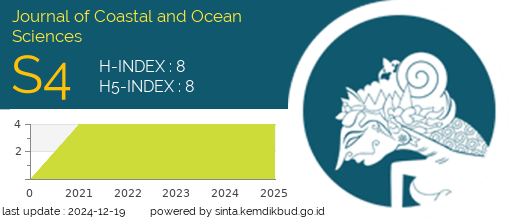Abundance and Diversity of Phytoplankton in Mangrove Forest Waters of Aek Horsik Village, Central Tapanuli
DOI:
https://doi.org/10.31258/jocos.5.2.94-100Keywords:
Waters, Forest Mangrove, PhytoplanktonAbstract
Phytoplankton are organisms that live floating in water. Its ability to move is limited, so the organism is always carried away. The waters of mangrove forests in Tapanuli Tengah Regency are directly adjacent to the shoreline, where phytoplankton always follow the current. At high tide, phytoplankton are carried by currents to mangrove forests; at low tide, phytoplankton can be carried by currents to free ocean waters. This study aims to determine the type of phytoplankton, phytoplankton abundance, and the level of phytoplankton diversity in the Mangrove Forest Waters of Aek Horsik Village, Tapanuli Tengah Regency. This research will be conducted from May to June 2023. Phytoplankton samples were taken using the purposive sampling method, and the research station was divided into 3. Station 1 is upstream of the mangrove forest, station 2 is in the middle of the mangrove forest, and station 3 is downstream. The results of this study showed that phytoplankton found in the waters of the Mangrove Forest, Aek Horsik Village, Tapanuli Tengah Regency consisted of 5 classes totaling 15 species, namely: Class Cyanophyceae (Synedra sp), Class Euglenophyceae (Euglena viridis sp, E.protista, and Euglena sp), Class Chlorophyceae (Ankistrodesmus sp, Scenedesmus sp, Tetraedron caudatum, Closterium acutum), Class Baciliarophyceae (Navicula sp, Nitzchia sp, Tabellaria sp, Nitzchia sigma), and Class Zygnematophyceae (Cosmarium sp, Staurastrum sp, S. curvacum). The highest phytoplankton abundance was 6100 Ind/L. Phytoplankton diversity is in the medium category, with the highest value being 2.671
Downloads
References
Afif, A., Widianingsih, W., & Hartati R. (2014). Komposisi dan Kelimpahan Plankton di Perairan Pulau Gusung Kepulauan Selayar Sulawesi Selatan. Journal of Marine Research, 3(3): 324-331
Aini, A.Q.Y., Idrus, A.A., & Japa, L. (2018). Komunitas Plankton pada Perairan Habitat Mangrove di Gili Sulat Lombok Timur. Prosiding Seminar Nasional Pendidikan Biologi.
Ayuingtyas, C.W., Yona, D., Syarifah, H.J., & Irnawati, F. (2019). Kelimpahan Mikro Plastik di Bayuurip, Gresik, Jawa Timur. Journal of Fisheries and Marine Research, 3(1): 41-45.
Balqis, N., El Rahimi, S.A., & Damora, A. (2021). Keanekaragaman dan Kelimpahan Fitoplankton di Perairan Ekosistem Mangrove Desa Rantau Panjang, Kecamatan Rantau Selamat, Kabupaten Aceh Timur. Jurnal Kelautan dan Perikanan Indonesia, 1(1): 35-43.
Batubara, L.W., Sihombing, N.S., & Daeli, J.S. (2023). Kelimpahan dan Pola Sebaran Kerang Lokan (Geloina erosa) Diperairan Hutan Mangrove Kelurahan Aek Horsik Kabupaten Tapanuli Tengah. TAPIAN NAULI: Jurnal Penelitian Terapan Perikanan dan Kelautan, 5(2): 40-45.
Burhanuddin, A.I. (2018). Pengantar Ilmu Kelautan dan Perikanan. Deepublish.
Dimenta, R.H., Khairul, K., & Machrizal, R. (2018). Studi Keanekaragaman Plankton Sebagai Pakan Alami Udang pada Perairan Ekosistem Mangrove Belawan, Sumatera Utara. Jurnal Pembelajaran dan Biologi Nukleus, 4(2): 18-23.
Gurning, L.F.P., Nuraini, R.A.T., & Suryono, S. (2020). Kelimpahan Fitoplankton Penyebab Harmful Algal Bloom di Perairan Desa Bedono, Demak. Journal of Marine Research, 9(3): 251-260.
Hamzah, F., Tito, C.K., & Pancawati, Y. (2015). Pengaruh Faktor Lingkungan terhadap Struktur Komunitas Plankton pada Ekosistem Mangrove Muara Angke, Jakarta Utara. Balai Penelitian dan Observasi Laut, (2015): 1-14
Hutami, H.G., Muskananfola, R.M., & Sulardiono, B. (2017). Analisis Kualitas Perairan Perairan pada Ekosistem Mangrove berdasarkan Kelimpahan Fitoplankton dan Nitrat Fosfat di Desa Bedono Demak. Journal of Maquares, 6(3): 239 – 246.
Kepmen-LH No. 51 Tahun 2004, Tentang Baku Mutu Air Laut.
Lathifah, N., Hidayat, J.W., & Muhammad, F. (2017). Struktur Komunitas Fitoplankton sebagai Dasar Pengelolaan Kualitas Perairan Pantai Mangrove di Tapak Tugurejo Semarang. Bioma: Berkala Ilmiah Biologi, 19(2): 164-169.
Masithah, E.D. (2020). Cyanophyta, Antagonisme Pembunuh dan Pionir Kehidupan. Universitas Airlangga News.
Rahmatullah, R. (2016). Keanekaragaman dan Dominansi Plankton di Estuari Kuala Rigaih Kecamatan Setia Bakti Kabupaten Aceh Jaya. Syiah Kuala University.
Riyantini, I., Ismail, M.R., & Mulyani, Y. (2020). Zooplankton sebagai Bioindikator Kesuburan Perairan di Hutan Mangrove Teluk Ciletuh, Kabupaten Sukabumi. Akuatika Indonesia, 5(2): 86-93.
Suardiani, N.K., Arthana, I.W., & Kartika, G.R.A. (2018). Produktivitas Primer Fitoplankton pada Daerah Penangkapan Ikan Di Taman Wisata Alam Danau Buyan, Buleleng, Bali. Jurnal Current Trends in Aquatic Science, 1(1): 8-15.
Wisha, U.J, Yusuf, M., & Maslukah, L. (2016). Kelimpahan Fitoplankton dan Konsentrasi TSS sebagai Indikator Penentu Kondisi Perairan Muara Sungai Porong. Jurnal Kelautan: Indonesian Journal of Marine Science and Technology, 9(2): 122-129.
Wiyarsih, B., Endrawati, H., & Sedjati, S. (2019). Komposisi dan Kelimpahan Fitoplankton di Laguna Segara Anakan, Cilacap. Buletin Oseanografi Marina 8(1): 1-8.






